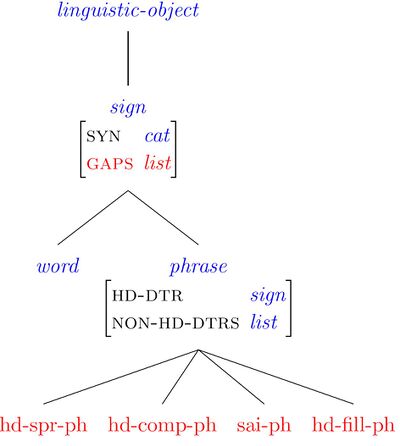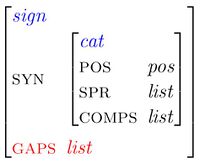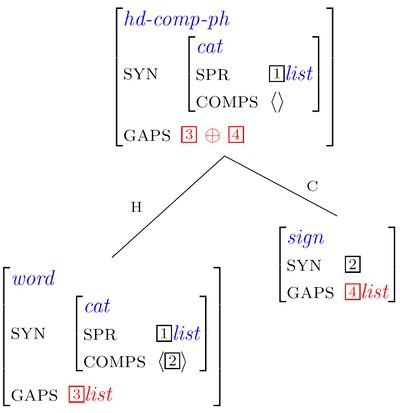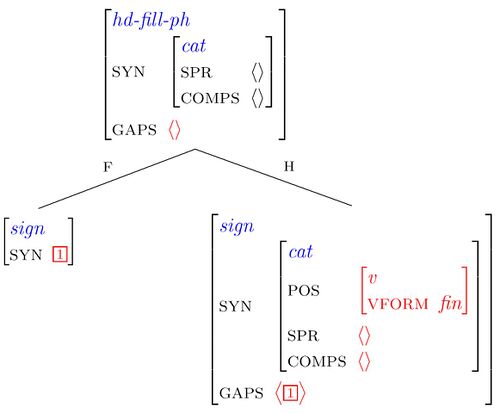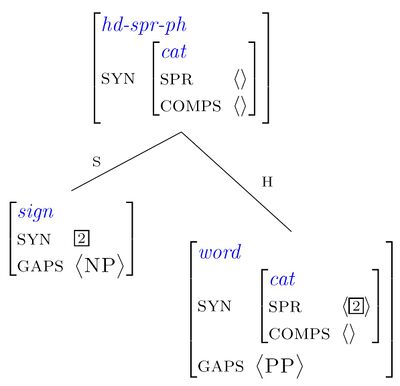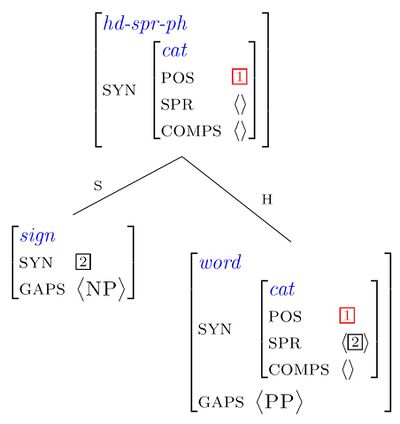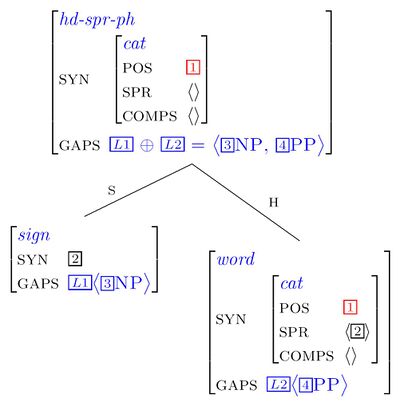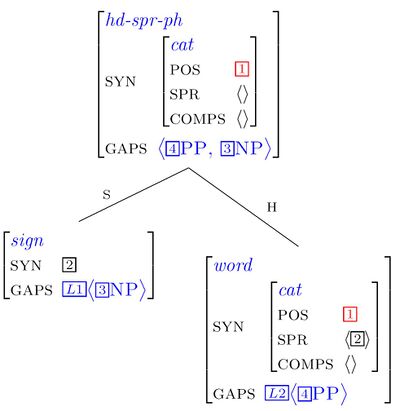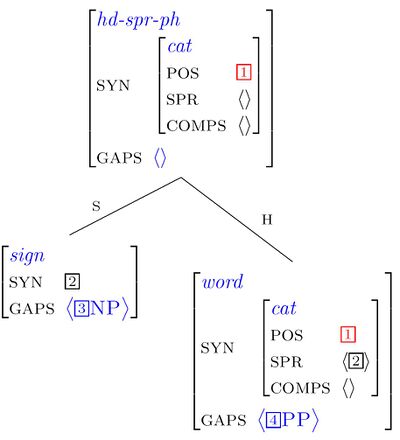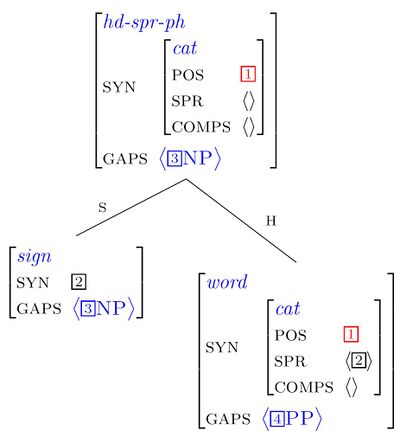Syntax 1 Wiki: Week 8
Step 2 Licensing the extra expression at the beginning of the sentence
The second problem we need to solve in order to license expressions like her she likes is the occurrence of her at the beginning of the sentence. None of the 3 schemas in Online Grammar 1 licences this extra sign to the left of the subject. So, we have no choice but to formulate a new schema. Here it is:
The Head-filler schema (non-final version)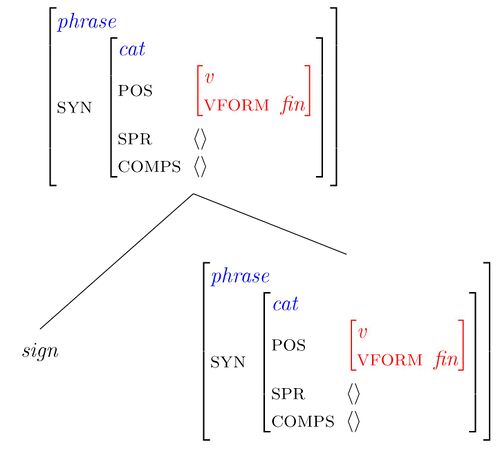
The top node and the second daughter of the schema represent complete finite sentences. The first daugher can be any sign. This schema licenses her as the first daugther of a finite sentence whose second daughter is she likes.
Exercise:
- Go to the Online Grammar 2, which contains the gap and the schema above.
- Parse the following strings:
- him Lilly likes (choose solution 1)
- him Lilly spoke to (choose solution 3)
- to him Lilly spoke (choose solution 4)
This solves the second problem: complete sentences can have an extra sign before the subject.
Unfortunately, it is too early to open the champagne
Exercise:
- Go back to Online Grammar 2.
- Parse the following strings:
- he Lilly likes (choose solution 1)
- he Lilly spoke to (choose solution 1)
What problem does the grammar output for the sentences above bring into the open?
Check your answer
The grammar licenses
1. sentences with a gap, and
2. sentences with an extra expression at the beginning of the sentence.
The problem is that the grammar does not connect the two phenomena!
Exercise
- Study the following blocks of sentences carefuly and look for a pattern in the data:
(1)
a. Lilly likes him.
a'. Him Lilly likes __.
b. *Lilly likes he.
b'. *He Lilly likes __.
c. *Lilly likes to him .
c'. *To him Lilly likes __.
(2)
a. Lilly depends on him.
a'. Him Lilly depends on __.
b. *Lilly depends on he.
b'. *He Lilly depends on __.
(3)
a. Lilly depends on him.
a'. On him Lilly depends __.
b. *Lilly depends him.
b'. *Him Lilly depends __.
(4)
a. Lilly said that I like him.
a'. Him Lilly said that I like __.
b. *Lilly said that I like he.
b'. *He Lilly said that I like __.
(5)
a. Lilly said that I believed that she likes him.
a'. Him Lilly said that I believed that she likes __.
a. *Lilly said that I believed that she likes he.
a'. *He Lilly said that I believed that she likes __.
What pattern do (1)-(5) show?
Check your answer
An expression can be preposed from a position P if and only if it can occur in position P.
Consequence: the gap and the extra expression at the left edge of the sentence need to be connected!
Introducing the GAPS feature
The last section showed that not just any extra expression can be added at the left edge of the sentence that contains a gap. Rather, the syntactic category of the gap and the extra expression must harmonize with each other. When that is the case, we say that the extra expression fills the gap. Such harmony between filler and gap requires that information about the gap must flow to the filler. In the following we will develop a technique that makes such an information flow possible.
First, we add the feature GAPS to the type sign. For any sign, the value of GAPS is the list of the categories of all the gaps that the sign contains:
Simultaneously, for each of the syntactic schemas that we have used to create phrases, we add a subtype to the type phrase which is named after the schema that forms that phrase, e.g. hd-comp-phrase, hd-spr-phrase, etc. See the subtypes in red in the portion of the type hierarchy above.
Requiring all signs to have the GAPS feature with value list leads to the following general structure of the type sign:
Since the gap is a sign, it also must have the list-valued GAPS feature. Study the following revised structure of the gap carefully:
The Definition of the Gap (final version)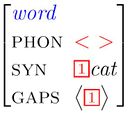
The gap has the following exclusive property: it is the only sign which stores its own syntactic category in its GAPS list. Unlike the gap, all words with a non-empty phonology are not allowed to contain any information in their GAPS lists:
The Empty GAPS Constraint
The non-empty GAPS list of the gap serves as the basis for the information flow from the gap to its filler, as we will now show.
The Gap Collection Constraint
We formulate the following constraint on head-complement and head-specifier phrases:
The Gap Collection ConstraintThe GAPS list of a hd-comp-ph and a hd-spr-ph contains all and only the members of the GAPS lists of the phrase's daughers.
⊕ is the list merger operator (to merge = verschmelzen): it merges two lists into one.
We illustrate the impact of the Gap Collection Constraint with the new general structure of head-complement phrases shown below (the effect is shown in red):
So, if one of the daughters of a hd-comp-ph is or contains a gap, then the information about the gap flows from the daughter's GAPS list to the mother's gaps list. If the GAPS lists of both daughers are empty, then the GAPS list of the mother is empty as well.
- Go to Online Grammar 3, which contains the new gap and the Gap Collection Constraint.
- Parse the following string:
- to
Look at solution 2 first and note two things:
- to has an empty GAPS list; this is so because the gap is the only word which is permitted to have a non-empty GAPS list.
- like a typical preposition, to selects an accusative NP category as its complement.
Remembering these two points, now look at solution 1. The first thing to note is the second daughter: instead of the spelling of the node, there is an underscore (__). You see why if you click on the N node and then on the PHON value: it is the empty list. The underscore thus marks the gap.
Next, click on the GAPS value of the gap. As expected, it is a list with one element in it, namely the syntactic category of the gap. Now, click on the SYN value of the gap. It is the category of an accusative NP, just what we saw in solution 1 as the category that to selects as its complement. You can convince yourself of that one more time by opening the structure of to and the COMPS value of that structure as well. As a matter of fact, you didn't have to open the COMPS list of to to know that it represents an accusative NP. Note that the single complement of to and the SYN value of the gap are both tagged with a boxed 0: these categories are thus one and the same object.
What causes the identity between the complement of to and the SYN value of the gap?
Check your answer
The head-complement schema.
What causes the identity between the SYN value of the gap and the member of the gap's GAPS list?
Check your answer
The definition of the gap.
What causes the identity between the complement of to and the member of the gap's GAPS list?
Check your answer
The transitivity of identity: if A is identical to B and B is identical to C, then A is also identical to C.
- Now parse the strings below and look at the GAPS of every node. For every tree node, explain why its GAPS has the value it has, based on the interation of
a. the definition of the gap
b. the Empty Gaps Constraint, and
c. the Gap Collection Constraint.
- speaks to (choose solution 1)
- Lilly speaks to (choose solution 1)
Before we move on to complete our analysis, convince yourelf one more time that the SYN value of the gap in the last sentence above is the only member of the top node's GAPS list. This means that the top node "knows" the syntactic category of the gap contained inside of it. Now, only one last step is needed to fill the gap.
Step 3: The Head-filler schema
Recall that we had stated a schema that made it possible to license an extra phrase at the left edge of a sentence. The problem with that schema was that it did not restrict the choice of filler based on the gap. The system predicted both of the strings below to be grammatical:
(1) Him Lilly likes __.
(2) *He Lilly likes __.
Given the grammar of GAPS that we have developed, this shortcoming is now easy to remove. Study the following schema carefully, in particular the last lines of all three nodes:
The second daughter, the head daughter, is finite and valence-complete (i.e. a sentence), but has a non-empty GAPS list. So, the head daughter is still in this respect incomplete. The root node, in contrast, has an empty GAPS list, which means that the gap in its head daughter is filled. How is it filled? There is only one choice: it is the non-head daughter which fills the head daughter's gap. The filler-gap relationship is expressed by the tag 1, which shows that the categories of the filler and the single member of GAPS of the head daughter are identical.
- Parse sentence (1) above and note that the grammar accepts it as an instance of the head-filler-phrase. Open the tree top nodes and check that the relationships between the values of the GAPS features in the nodes are the same as in the head-filler-schema above.
- Parse sentence (2) above and note that the grammar does not combine the words into a phrase.
- Finally, parse the following sentence:
- Him Lilly thought that she spoke to
Open the node of the filler and the node of the gap. Note that the filler's and the gap's SYN are identical. Now open the nodes above the gap until you reach the filler's sister. Compare the GAPS values of those nodes. Click on all the 0-tags, including the 0-tag of the gap and convince yourself of the following:
a. The gap's GAPS value is the list <7>, i.e. the list containing as its only member the gap's SYN value 7.
b. With the exception of the head-filler-ph all the way at the top, every node's GAPS value is the list <7> as well.
c. The filler's SYN value is 7 and therefore the same as the gap's SYN value, as mediated by the GAPS values of the nodes connecting the filler and the gap.
d. The GAPS value of the head-filler-ph is the empty list, since the gap 7 in its head daughter has been filled by its filler daughter.
Constraints
We have seen a number of constraints in this course:
The Head Feature Principle
The Gap Collection Constraint
We will discuss the nature of constraints more carefully now.
A constraint works as follows:
1. All constraints look as follows: A ⇒ C.
2. They consist of 3 parts: the antecedent A, the double arrow ⇒, and the consequent C.
3. The antecedent and the consequent describe the same feature structure.
4. The constraint A ⇒ C then has the following meaning: a feature structure that contains the information in A is well formed only if it also contains the information in C.
Exercises
For each of the following representations, state whether it satisfies the Head Feature Principle and the Gap Collection Constraint. If the structure is ill-formed, then state how it could be made compatible with the constraints that it violates.
Navigation:
